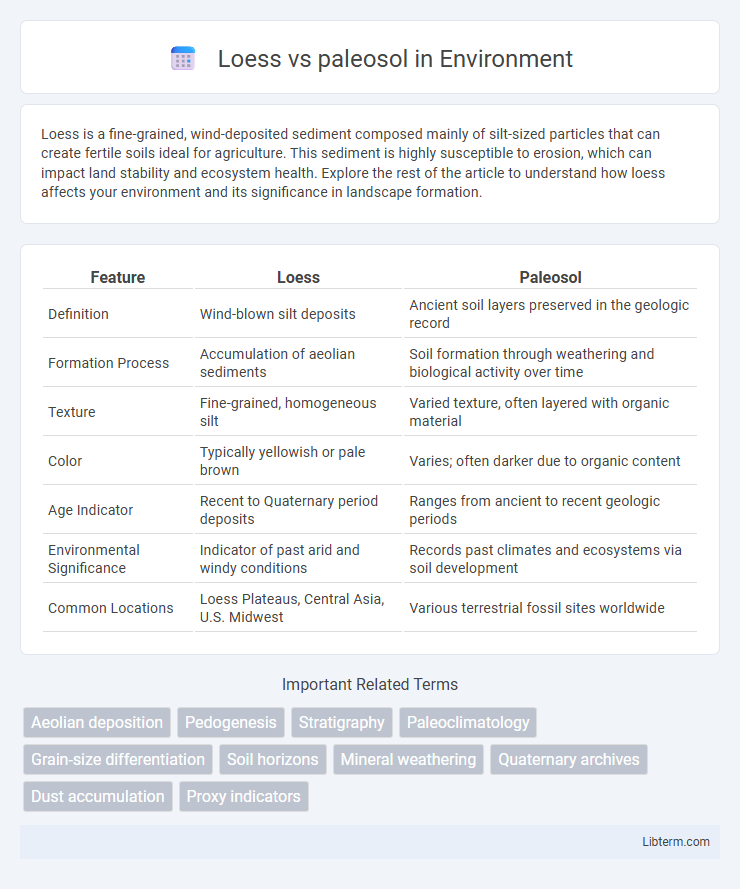Loess is a fine-grained, wind-deposited sediment composed mainly of silt-sized particles that can create fertile soils ideal for agriculture. This sediment is highly susceptible to erosion, which can impact land stability and ecosystem health. Explore the rest of the article to understand how loess affects your environment and its significance in landscape formation.
Table of Comparison
| Feature | Loess | Paleosol |
|---|---|---|
| Definition | Wind-blown silt deposits | Ancient soil layers preserved in the geologic record |
| Formation Process | Accumulation of aeolian sediments | Soil formation through weathering and biological activity over time |
| Texture | Fine-grained, homogeneous silt | Varied texture, often layered with organic material |
| Color | Typically yellowish or pale brown | Varies; often darker due to organic content |
| Age Indicator | Recent to Quaternary period deposits | Ranges from ancient to recent geologic periods |
| Environmental Significance | Indicator of past arid and windy conditions | Records past climates and ecosystems via soil development |
| Common Locations | Loess Plateaus, Central Asia, U.S. Midwest | Various terrestrial fossil sites worldwide |
Introduction to Loess and Paleosol
Loess is a wind-deposited, fine-grained sediment primarily composed of silt-sized particles, often forming extensive thick deposits in regions such as the Chinese Loess Plateau and the American Midwest. Paleosols are ancient soil horizons preserved within the geological record, providing vital information about past climate, vegetation, and landscape stability. Differentiation between loess and paleosols is crucial in Quaternary science for reconstructing paleoenvironments and understanding sedimentary processes.
Definition and Formation of Loess
Loess is a wind-deposited, fine-grained sediment primarily composed of silt-sized particles, forming extensive, homogeneous blankets typically during glacial and periglacial periods. Unlike paleosols, which are ancient soils formed through prolonged weathering and biological activity, loess represents primary aeolian deposits with minimal soil formation at the time of accumulation. The formation of loess involves the entrainment and long-distance transport of dust by strong winds, followed by its settling in stable environments where vegetation cover is sparse or absent.
Definition and Formation of Paleosol
Paleosol is a fossilized soil horizon formed through prolonged soil formation processes under past climatic and environmental conditions, preserving evidence of ancient ecosystems. Unlike loess, which is a wind-deposited, fine-grained sediment primarily composed of silt particles derived from glacial and desert sources, paleosol develops in situ by pedogenic processes including weathering, organic matter accumulation, and mineral transformation. The study of paleosols provides critical insights into paleoenvironmental reconstructions, paleoclimate, and landscape evolution, distinguishing them from loess deposits that mainly reflect aeolian sedimentation.
Key Differences Between Loess and Paleosol
Loess is a wind-deposited, silt-sized sediment characterized by its homogeneous, fine-grained texture and high porosity, while paleosol represents an ancient soil horizon that shows evidence of past biological activity and soil formation processes. Loess typically accumulates in thick, unstratified layers with minimal organic content, whereas paleosols exhibit distinct horizons, organic matter, and soil structures such as root traces and clay illuviation, indicating pedogenesis. The primary difference lies in their origin, with loess formed by aeolian deposition and paleosol resulting from in-situ soil development over long geological timescales.
Sedimentology and Composition
Loess primarily consists of fine, windblown silt-sized particles with minor clay and sand components, typically exhibiting uniform grain size and low organic content. Paleosols represent ancient soil horizons with complex sedimentological features, including varied grain sizes, visible soil structures, and enriched organic matter reflecting past weathering and biological activity. The contrast in composition and sedimentary structures between loess and paleosols provides key evidence for interpreting past climatic and environmental conditions.
Geological Significance
Loess and paleosol represent distinct geological records critical for reconstructing past environmental and climate conditions. Loess, composed primarily of wind-blown silt-sized particles, signifies periods of intense glacial activity and arid conditions, serving as a proxy for paleoclimatic studies. Paleosols, ancient soil horizons preserved within the stratigraphic record, provide evidence of past surface stability, vegetation, and atmospheric composition, making them essential for understanding long-term paleoenvironmental changes and terrestrial ecosystem evolution.
Role in Paleoclimate Reconstruction
Loess deposits, consisting mainly of wind-blown silt, serve as key archives of past climatic conditions by preserving evidence of glacial-interglacial cycles and vegetation changes through dust accumulation rates and particle size distribution. Paleosols, ancient soil horizons preserved within sedimentary sequences, provide detailed records of terrestrial climate, vegetation, and weathering intensity during periods of landscape stability, reflecting local temperature and precipitation variations. Combining loess and paleosol data enhances paleoclimate reconstructions by integrating aeolian sedimentation patterns with soil formation processes indicative of past environmental dynamics.
Soil Fertility and Agricultural Implications
Loess, composed of fine, wind-blown silt particles, typically offers high soil fertility due to its rich mineral content and excellent water retention, promoting robust crop growth. Paleosols, ancient soils preserved within sediment layers, may exhibit variable fertility influenced by historical climate and vegetation, often requiring amendments to restore agricultural productivity. Understanding the distinct nutrient profiles and physical properties of loess and paleosols aids in optimizing land management and crop selection for sustainable agriculture.
Global Distribution of Loess and Paleosol
Loess deposits are predominantly found along major river valleys and wind-blown sediment areas such as the Chinese Loess Plateau, the Midwestern United States, and parts of Europe, indicating widespread Quaternary wind activity. Paleosols are globally distributed in ancient sedimentary sequences, serving as key indicators of past climatic and environmental conditions in regions like the European loess belt, Siberia, and the American Midwest. Both loess and paleosols provide crucial stratigraphic records, but loess typically marks aeolian accumulations while paleosols represent in situ soil formation processes across diverse paleoenvironments.
Summary and Future Research Directions
Loess deposits primarily consist of wind-blown silt with high porosity and fertility, while paleosols represent ancient soil horizons indicating past climatic and environmental conditions. Research should focus on integrating high-resolution stratigraphic, geochemical, and isotopic analyses to improve the understanding of loess-paleosol sequences as climatic archives. Future studies may explore advanced dating techniques and multi-proxy approaches to reconstruct paleoenvironmental changes with greater accuracy.
Loess Infographic

 libterm.com
libterm.com